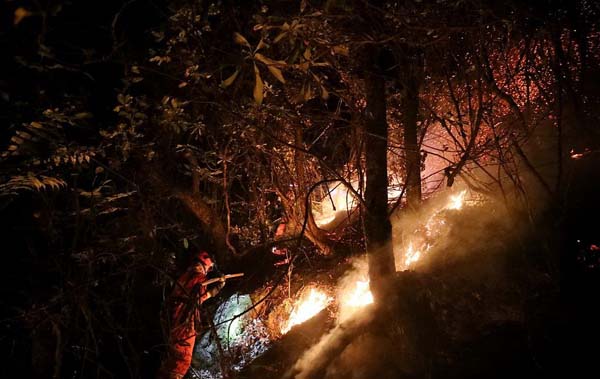The blaze in Sichuan province that claimed 30 lives is likely a rare but extremely dangerous and unpredictable type of wildfire known as eruptive fire, an expert said.
More scientific research and improvements in awareness and training for firefighters are key for preventing similar tragedies, said Liu Naian, deputy director of the State Key Laboratory of Fire Science.

Firefighters battle a forest fire in Mianning county, Liangshan Yi autonomous prefecture in Southwest China's Sichuan province, on March 28, 2019.
At about 6 pm on Saturday, a fire broke out in the alpine forest near the village of Li'er in the Liangshan Yi autonomous prefecture's Muli county. The firefighting effort was complicated by high altitude, complex terrain and difficulties with transportation and communications.
Twenty-seven of the 30 people killed were firefighters, according to the Ministry of Emergency Management. All of the bodies have been recovered, and the ministry's website was switched to black and white to mourn the losses.
Based on reports, Liu said the tragedy was likely caused by an eruptive fire, which typically occurs in steep valleys. It is also one of the main causes of human casualties in fighting forest fires around the world.
"There is very little scientific literature on modeling or predicting occurrences of this phenomenon," he said. However, scientists have hypothesized that it might be caused by a mixture of air and combustible gas forming a highly flammable mixture at the bottom of the valley.
"In a typical forest fire, flames spread relatively slowly, traveling dozens or hundreds of meters per hour, with some intense cases going as fast as 10 kilometers per hour," he said.
"However, when fire breaks out in a valley, the flames may burn close to the sides of the valley due to unbalanced air flow and pressure, thus covering more vegetation and burning more rapidly and intensely," he said.
At the same time, the fire will produce gases that can mix with air and sink to the bottom of the valley. "A tiny spark is enough to ignite the highly flammable gas mixture, creating an eruption of flames that can engulf the entire valley within minutes," Liu said.
The recent strong winds in the area also fueled the fire with more oxygen and made it more violent, Liu said. "There is very little time to react when an eruptive fire happens," he added.
In December 2010, a wildfire in Daofu county, Sichuan province, turned eruptive and killed 15 firefighters, five civilians and two forestry workers in less than a minute.
There is currently no effective way for firefighters in the field to predict eruptive fire. "One piece of advice is to take precautions, such as cleaning up the fire scene as the flames are being put out," Liu said.
"Firefighters should also avoid staying at the bottom of a valley. But they might not be aware of the danger of an eruptive fire since it rarely occurs and its behavior and solutions are still being studied," he added.


